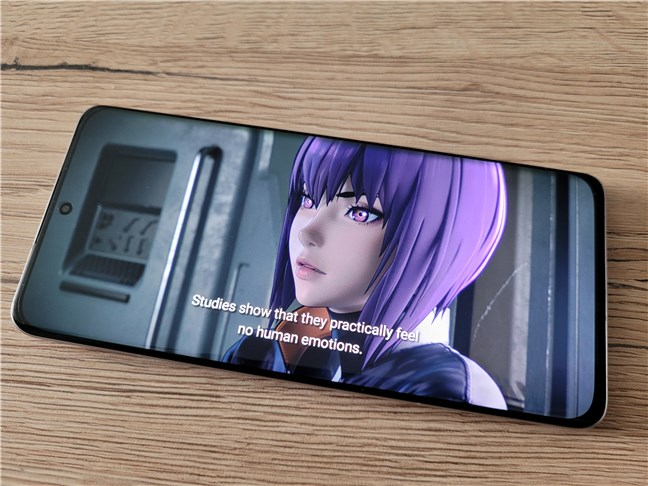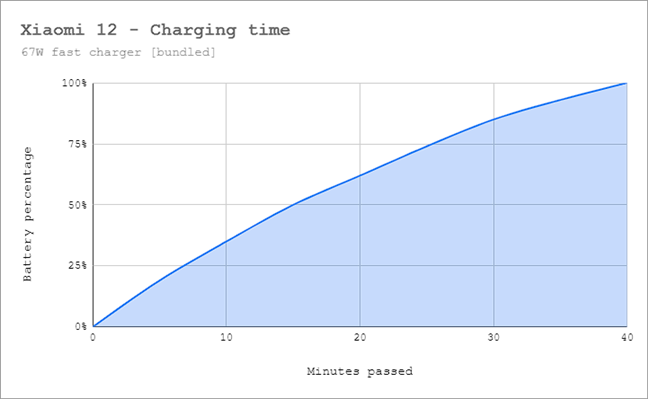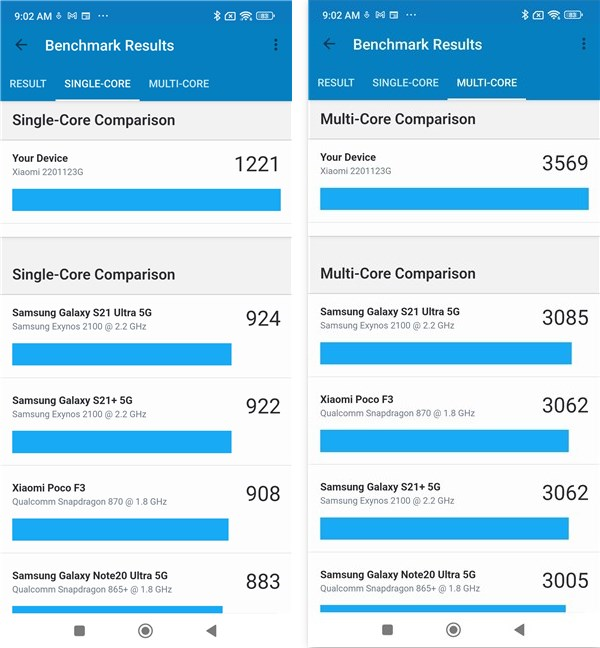
The smartphone experience on the Xiaomi 12
In terms of phone call quality and mobile connectivity, the Xiaomi 12 is loud and clear for both persons on the line. In 99% of the cases, I had no issues with signal reception. There was only one phone call that got dropped, but I can’t blame that on the smartphone itself. I was using VoWiFi (Voice over Wi-Fi), and the wireless network the Xiaomi 12 was using had issues.
I’ll continue by acknowledging the fact that this smartphone’s screen is amazing. As you know by now, the Xiaomi 12 uses an AMOLED display, which says a lot right from the start: bright whites and deep blacks are ensured by that. But that’s not all; the colors are also more than impressive, as this is one of the few Android devices out there that supports 12-bit color depth. That translates into 68 billion colors! I used the Xiaomi 12 to watch more than just a few movies and, obviously, YouTube videos, and I did that not only inside during evenings but also outside on sunny days. Suffice to say, the screen was able to compensate for brightness and look gorgeous even in direct bright sunlight.

Watching movies on the Xiaomi 12 is a delight
Sound-wise, the audio quality is excellent too. The two stereo speakers are well-calibrated and also quite loud. And I kind of like their positioning. Found on the top and bottom sides of the phone’s body, they are not facing you directly, making it feel like the sound is a bit wider than on other smartphones. However, the not-so-good aspect is that you can easily cover the speakers with your palms if you hold the phone in landscape orientation.
I’ve also played several games that demand powerful hardware to run well. To name just two of them: The Elder Scrolls: Blades and Asphalt 9. The performance offered by the Xiaomi 12 was top-notch - visuals maxed out, and no lags. Furthermore, the smartphone only got mildly warm, not hot, even after playing for long periods of time.

Gaming is excellent on the Xiaomi 12
I’m also quite satisfied with the overall user experience offered by the Xiaomi 12. The operating system, user interface, and apps work flawlessly and without any kind of stuttering or lags. The fingerprint sensor and face unlocking features are fast and accurate, and the battery life is OK. To elaborate a bit on the latter, I’m not what you’d call a heavy user of the smartphone. I do spend a couple of hours each day browsing the web, reading news, and watching videos, but I’m not glued to the smartphone’s screen. So, except for the day in which I benchmarked and played games on the Xiaomi 12, its battery managed to last for about one and a half to two days on a charge.
Which brings us to the next and one of the most important features of the Xiaomi 12 in my opinion: charging times. It’s fast! Using the 67W charger bundled with the smartphone, the Xiaomi 12 got from 0 to 100% battery in about 40 minutes!

Xiaomi 12: Battery charging time chart
I loved using the Xiaomi 12 as my main smartphone for as long as I had it in testing. The performance it offers in everyday use and in games is excellent, and so is its connectivity, display and audio are great, and charging is very fast.
The camera experience on the Xiaomi 12
NOTE: For optimization purposes, the pictures in this review are resized. If you want to see the full-sized original photos and videos I shot with the Xiaomi 12, open this gallery:
The camera system on the Xiaomi 12 is one of the best ones I’ve seen lately. The main camera is especially good, and the ultrawide, macro, and selfie are also better than most. The obvious thing missing here is a telephoto camera, which unfortunately can’t be replaced by the 2x zoom offered by the main camera.
Taking a peek first at the Camera app, there’s nothing out of the ordinary here. It’s the same app found on other Xiaomi smartphones, with all the standard options and shooting modes such as HDR, AI, Super Macro, Night, 50MP, or Slow Motion. To get to some of the available modes, you’ll have to tap the More button.

The Camera app on the Xiaomi 12
By default, the Xiaomi 12 main camera shoots photos in 12 megapixels. Although the sensor has 50 MP and the Camera app has a mode for that, I don’t recommend using it too often, as the photo quality is actually not better, losing some sharpness and appearing to be softer, all for just a tiny bit of added detail. If the lighting conditions are good, on a sunny day, for example, the main camera takes excellent photos: high dynamic range, plenty of detail, good contrast, and natural colors. Here’s an example:

A photo shot with the Xiaomi 12
Here’s what the same scene looks like in 2x zoom:

A 2x-zoom photo captured with the Xiaomi 12
The ultrawide camera is also surprisingly good. It manages to capture good detail, and, except for the usual wide-angle distortion, contrast and colors are very close to the ones you get from the main camera.

Ultrawide photograph shot with the Xiaomi 12
The dedicated 5 MP macro camera is also much better than the usual 2-megapixel ones I’ve seen on many smartphones. I find it to offer good exposure and contrast, as well as adequate detail:

Macro photo quality is actually good
What about low-light photos, more exactly night photographs? The Night mode on the Xiaomi 12 is possibly the fastest one I’ve seen. It only takes a second or two, and the phone captures the photo. The results are great: there is only a little bit of noise, while the images have plenty of detail and good contrast.

Xiaomi 12 takes excellent night photos
Videos are also of good quality: detailed and with excellent color reproduction. Take a look below to see what a daylight video looks like when using the Camera app on default settings - 1080p at 30 frames per second (fps):
The Xiaomi 12 can record in up to 8K resolution if you’re OK with 24 fps, but, if you want something smoother, 4K in 60 fps is what I recommend. The level of detail is excellent, and colors are well represented, though anything above 1080p looks a bit softer:
The slow-motion modes are also amazing. The Xiaomi 12 can record at a speed of up to 960 fps in 1080p resolution and up to 1920 fps in 720p. Here’s a sample recorded at maximum speed:
The cameras on the Xiaomi 12 are some of the best I’ve seen and I believe this smartphone deserves its place among the best camera-phones out there. The only thing missing is a telephoto camera; 2x zoom might be too small for some people.
Android 12 and bundled apps
The Xiaomi 12 runs on MIUI 13, the company’s own flavor of Android 12. According to its policy, the Chinese manufacturer will offer three Android updates and four years of security updates on the phones it has released since September 2021. That includes the Xiaomi 12.
Moving on to the actual operating system and installed software, what you should know is that MIUI 13 showcases a beautiful user interface with many customization options and small tricks to make it more useful than the default Android 12 one.

Apps installed on the Xiaomi 12
Besides all the regular apps from Google and the standard ones in Android 12, Xiaomi 12 also bundles the following apps:
- Amazon Shopping - the app of the largest online store in the Western world
- Compass - useful for finding out where the North is, as well as measuring elevation and atmospheric pressure
- Facebook - the social network we all love to hate
- File Manager - useful for working with the files and folders on your Xiaomi 12
- Mi Browser - a web browser made by Xiaomi
- Mi Remote - allows you to control various devices using the smartphone’s built-in infrared sensor
- Mi Video - an app that you can use to watch videos, both offline and online
- Music - an audio player app that you can also use to stream music
- Netflix - one of the most popular movies and TV series streaming service
- Notes - a simple note-taking app
- Recorder - a voice recording app
- Scanner - a QR scanning app
- Security - Xiaomi’s app for actions regarding your phone’s security and management
- Services & feedback - Xiaomi’s app for submitting feedback and getting help
- Spotify - the mobile app of the popular music and podcast streaming service
- ShareMe - can help you transfer files using Bluetooth and Wi-Fi without having to connect to the internet
- Weather - shows you the weather using data collected mainly from Accuweather
Xiaomi 12 uses the company’s latest MIUI 13 user interface, based on the latest Android 12 operating system. It looks good and works well, and there aren’t too many bundled apps. Although not all, some of them can be easily uninstalled if you don’t need or want them on your phone, which is a good thing.
Performance in benchmarks
Personal opinions about performance are subjective ones. That’s why every review needs to include benchmarks too. Here’s the story they tell about the Xiaomi 12:
I started with Geekbench: Xiaomi 12 scored 1221 points in the Single-Core test and 3569 points in Multi-core. Both numbers are excellent, similar, but a bit higher than what you get from a Samsung Galaxy S22+ and better than what a Samsung S22 (Exynos) can deliver.

Xiaomi 12: Geekbench 5 benchmark results
Next, I wanted to see how powerful the Xiaomi 12 is in terms of graphics. For that, I ran 3DMark’s Wild Life and Wild Life Extreme. To be noted, I also tested the phone Sling Shot and Sling Shot Extreme, but the results were so good that they maxed out. 🙂 In Wild Life, Xiaomi 12 managed a score of 8694 points, and in Wild Life Extreme, 2510 points. Amazing results, in my opinion. For the sake of comparison, the Samsung Galaxy S22 (Exynos) is able to deliver only about 80~83 levels of performance compared to the Xiaomi 12!

Xiaomi 12: 3DMark benchmark results
Also on the graphics side of things, I decided to test the Xiaomi 12 with another benchmark: GFXBench. I chose the Car Chase and 1080p Car Chase Offscreen tests, and the number of fps (frames per second) rendered by the Xiaomi 12 was extremely impressive in both. It manages to render more than 26% fps compared to a Samsung Galaxy S22 (Exynos)!

Xiaomi 12: GFXBench results
Next, I turned to PCMark for Android, which can test both performance and battery life in real-world scenarios. Xiaomi 12 scored 13114 points in the Work 3.0 performance test and managed a runtime of 10 hours and 26 minutes in the Work 3.0 battery life test. The performance score is excellent, and the battery results are good. Better than what you get from a Samsung Galaxy S22 but not as enduring as the Samsung Galaxy S22+. Maybe a future update will improve the battery life? Let’s hope so.

Xiaomi 12: PCMark performance and battery life scores
Unfortunately, I can’t test 5G connection speeds as my mobile provider doesn’t offer coverage in my area. However, I can test Wi-Fi 6 speeds. I have a 1Gbps internet connection that, in real life, usually goes up to 750Mbps. Using Ookla’s Speedtest, the Xiaomi 12 managed up to 718Mbps for download and 617Mbps for upload.

Xiaomi 12: SpeedTest results on WiFi 6
The Xiaomi 12 offers incredible performance in benchmarks, taking its rightful place among the best Android smartphones of 2022. It’s fast and powerful, able to run any app or game without any kind of issue, and at the highest quality. The only thing holding it back a little is battery life.
Do you like the Xiaomi 12?
As you know now, I like the Xiaomi 12 a lot. I find it to be an excellent smartphone, with top-notch performance, good cameras, and many other boxes ticked right. Do you feel the same? Are you thinking of buying it? Let me know in the comments section below.


 18.05.2022
18.05.2022 


